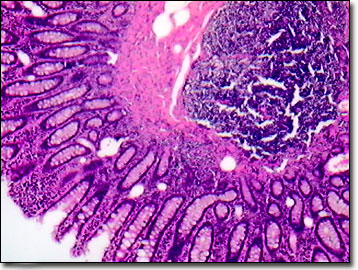Brightfield Digital Image Gallery
Primate Colon
The colon or large intestine is the muscular tube of the gastrointestinal system that begins at the small intestine and ends at the rectum. Absorbing water and minerals, balancing electrolytes, and compacting fecal matter for elimination, comprise the main functions of the colon in primates.

Although the gastrointestinal systems of humans and other primates begin similarly in development, once in adulthood, nonhuman primates feature a larger gut to body mass ratio, dominated proportionally by the colon, in contrast to humans with dominant small intestines. The differences among the diets of humans and other primates may be reflected in this notable divergence of colon morphology, with nonhuman primates, such as gibbons and orangutans, consuming large quantities of plant remains of variable nutrient quality. Often low energy levels of the larger primates such as gorillas and orangutans are accompanied by lower quality foods. With the decrease in the human colon size evolutionarily and developmentally, and a corresponding increase in the small intestine volume, there is probably an increased demand in energy requirement without a corresponding increase in dietary quality.
In the Human Genome Project, a gene that accommodates, or even promotes, cancer of the colon in primates was discovered. In the past, because of legal and ethical restrictions on experimenting on human subjects, pharmacology and radiology researchers readily employed nonhuman primate models for colon cancer research. Animal rights activists have raised concerns about using our simian cousins for such research, particularly when there are newer cultured tissue and computer simulation tools available.
Contributing Authors
Cynthia D. Kelly, Thomas J. Fellers and Michael W. Davidson - National High Magnetic Field Laboratory, 1800 East Paul Dirac Dr., The Florida State University, Tallahassee, Florida, 32310.
BACK TO THE BRIGHTFIELD IMAGE GALLERY
BACK TO THE DIGITAL IMAGE GALLERIES
Questions or comments? Send us an email.
© 1995-2025 by Michael W. Davidson and The Florida State University. All Rights Reserved. No images, graphics, software, scripts, or applets may be reproduced or used in any manner without permission from the copyright holders. Use of this website means you agree to all of the Legal Terms and Conditions set forth by the owners.
This website is maintained by our
Graphics & Web Programming Team
in collaboration with Optical Microscopy at the
National High Magnetic Field Laboratory.
Last Modification Friday, Nov 13, 2015 at 01:19 PM
Access Count Since September 17, 2002: 11768
Visit the website of our partner in introductory microscopy education:
|
|
